Data Management Strategy
VerifiedAdded on 2023/03/31
|13
|4433
|435
AI Summary
This report discusses the data management strategies for feral and stray cats in New Zealand, including data quality indicators and conceptual data modeling.
Contribute Materials
Your contribution can guide someone’s learning journey. Share your
documents today.

Running head: DATA MANAGEMENT STRATEGY
Data Management Strategy
Name of the Student
Name of the University
Author Note
Data Management Strategy
Name of the Student
Name of the University
Author Note
Secure Best Marks with AI Grader
Need help grading? Try our AI Grader for instant feedback on your assignments.
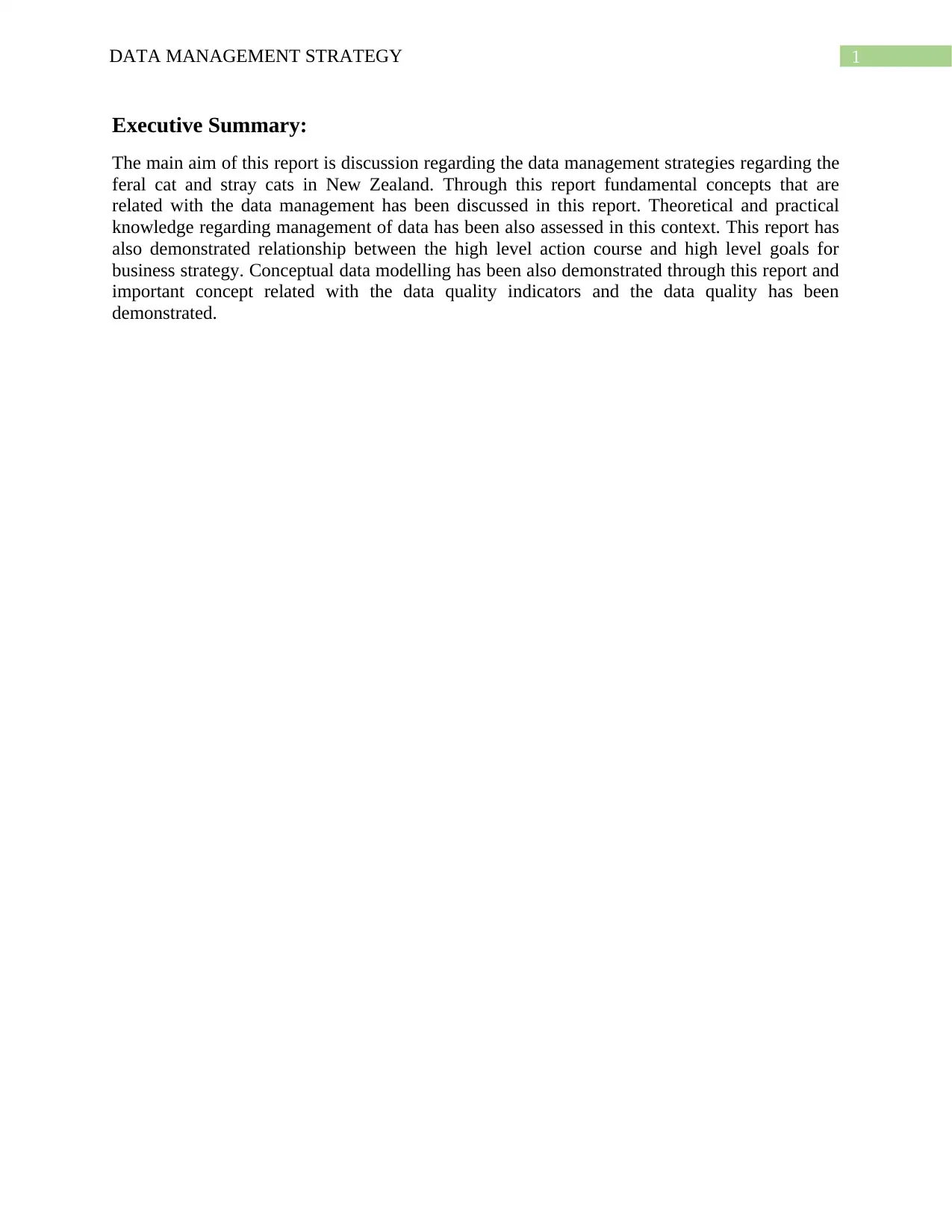
1DATA MANAGEMENT STRATEGY
Executive Summary:
The main aim of this report is discussion regarding the data management strategies regarding the
feral cat and stray cats in New Zealand. Through this report fundamental concepts that are
related with the data management has been discussed in this report. Theoretical and practical
knowledge regarding management of data has been also assessed in this context. This report has
also demonstrated relationship between the high level action course and high level goals for
business strategy. Conceptual data modelling has been also demonstrated through this report and
important concept related with the data quality indicators and the data quality has been
demonstrated.
Executive Summary:
The main aim of this report is discussion regarding the data management strategies regarding the
feral cat and stray cats in New Zealand. Through this report fundamental concepts that are
related with the data management has been discussed in this report. Theoretical and practical
knowledge regarding management of data has been also assessed in this context. This report has
also demonstrated relationship between the high level action course and high level goals for
business strategy. Conceptual data modelling has been also demonstrated through this report and
important concept related with the data quality indicators and the data quality has been
demonstrated.

2DATA MANAGEMENT STRATEGY
Table of Contents
Introduction:....................................................................................................................................3
Data Management Strategy:............................................................................................................3
Business goal definition:..................................................................................................................3
Data Management Goals:................................................................................................................4
Short term goals:..........................................................................................................................4
Long Term Goals:........................................................................................................................5
Data Definition:...............................................................................................................................5
Conceptual data model:...................................................................................................................7
Action Plan for the Data Management Strategy:.............................................................................8
Data management program success indicators:...............................................................................8
Data quality:.................................................................................................................................8
Determining data quality:............................................................................................................8
Data quality indicators.....................................................................................................................9
Conclusion:......................................................................................................................................9
References:....................................................................................................................................11
Table of Contents
Introduction:....................................................................................................................................3
Data Management Strategy:............................................................................................................3
Business goal definition:..................................................................................................................3
Data Management Goals:................................................................................................................4
Short term goals:..........................................................................................................................4
Long Term Goals:........................................................................................................................5
Data Definition:...............................................................................................................................5
Conceptual data model:...................................................................................................................7
Action Plan for the Data Management Strategy:.............................................................................8
Data management program success indicators:...............................................................................8
Data quality:.................................................................................................................................8
Determining data quality:............................................................................................................8
Data quality indicators.....................................................................................................................9
Conclusion:......................................................................................................................................9
References:....................................................................................................................................11
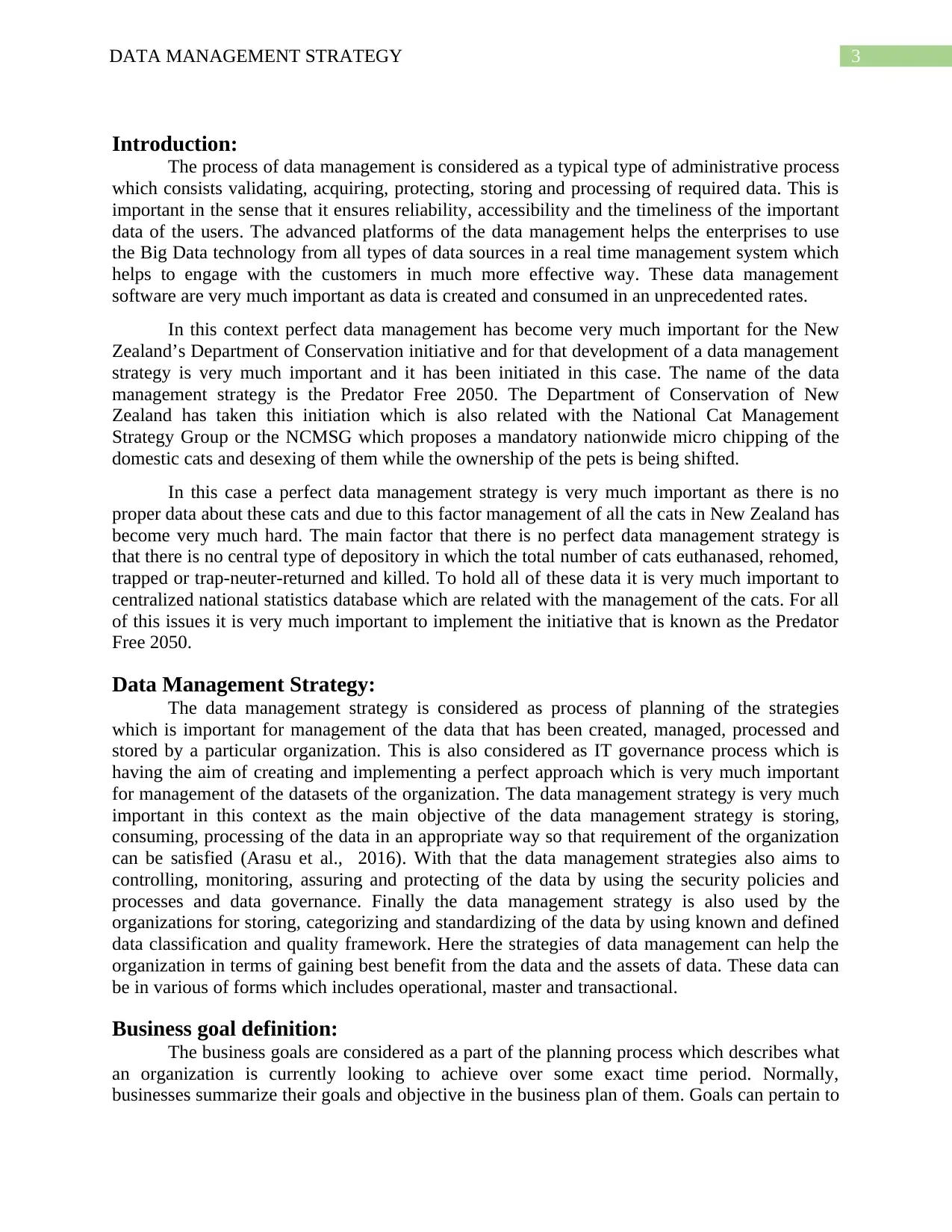
3DATA MANAGEMENT STRATEGY
Introduction:
The process of data management is considered as a typical type of administrative process
which consists validating, acquiring, protecting, storing and processing of required data. This is
important in the sense that it ensures reliability, accessibility and the timeliness of the important
data of the users. The advanced platforms of the data management helps the enterprises to use
the Big Data technology from all types of data sources in a real time management system which
helps to engage with the customers in much more effective way. These data management
software are very much important as data is created and consumed in an unprecedented rates.
In this context perfect data management has become very much important for the New
Zealand’s Department of Conservation initiative and for that development of a data management
strategy is very much important and it has been initiated in this case. The name of the data
management strategy is the Predator Free 2050. The Department of Conservation of New
Zealand has taken this initiation which is also related with the National Cat Management
Strategy Group or the NCMSG which proposes a mandatory nationwide micro chipping of the
domestic cats and desexing of them while the ownership of the pets is being shifted.
In this case a perfect data management strategy is very much important as there is no
proper data about these cats and due to this factor management of all the cats in New Zealand has
become very much hard. The main factor that there is no perfect data management strategy is
that there is no central type of depository in which the total number of cats euthanased, rehomed,
trapped or trap-neuter-returned and killed. To hold all of these data it is very much important to
centralized national statistics database which are related with the management of the cats. For all
of this issues it is very much important to implement the initiative that is known as the Predator
Free 2050.
Data Management Strategy:
The data management strategy is considered as process of planning of the strategies
which is important for management of the data that has been created, managed, processed and
stored by a particular organization. This is also considered as IT governance process which is
having the aim of creating and implementing a perfect approach which is very much important
for management of the datasets of the organization. The data management strategy is very much
important in this context as the main objective of the data management strategy is storing,
consuming, processing of the data in an appropriate way so that requirement of the organization
can be satisfied (Arasu et al., 2016). With that the data management strategies also aims to
controlling, monitoring, assuring and protecting of the data by using the security policies and
processes and data governance. Finally the data management strategy is also used by the
organizations for storing, categorizing and standardizing of the data by using known and defined
data classification and quality framework. Here the strategies of data management can help the
organization in terms of gaining best benefit from the data and the assets of data. These data can
be in various of forms which includes operational, master and transactional.
Business goal definition:
The business goals are considered as a part of the planning process which describes what
an organization is currently looking to achieve over some exact time period. Normally,
businesses summarize their goals and objective in the business plan of them. Goals can pertain to
Introduction:
The process of data management is considered as a typical type of administrative process
which consists validating, acquiring, protecting, storing and processing of required data. This is
important in the sense that it ensures reliability, accessibility and the timeliness of the important
data of the users. The advanced platforms of the data management helps the enterprises to use
the Big Data technology from all types of data sources in a real time management system which
helps to engage with the customers in much more effective way. These data management
software are very much important as data is created and consumed in an unprecedented rates.
In this context perfect data management has become very much important for the New
Zealand’s Department of Conservation initiative and for that development of a data management
strategy is very much important and it has been initiated in this case. The name of the data
management strategy is the Predator Free 2050. The Department of Conservation of New
Zealand has taken this initiation which is also related with the National Cat Management
Strategy Group or the NCMSG which proposes a mandatory nationwide micro chipping of the
domestic cats and desexing of them while the ownership of the pets is being shifted.
In this case a perfect data management strategy is very much important as there is no
proper data about these cats and due to this factor management of all the cats in New Zealand has
become very much hard. The main factor that there is no perfect data management strategy is
that there is no central type of depository in which the total number of cats euthanased, rehomed,
trapped or trap-neuter-returned and killed. To hold all of these data it is very much important to
centralized national statistics database which are related with the management of the cats. For all
of this issues it is very much important to implement the initiative that is known as the Predator
Free 2050.
Data Management Strategy:
The data management strategy is considered as process of planning of the strategies
which is important for management of the data that has been created, managed, processed and
stored by a particular organization. This is also considered as IT governance process which is
having the aim of creating and implementing a perfect approach which is very much important
for management of the datasets of the organization. The data management strategy is very much
important in this context as the main objective of the data management strategy is storing,
consuming, processing of the data in an appropriate way so that requirement of the organization
can be satisfied (Arasu et al., 2016). With that the data management strategies also aims to
controlling, monitoring, assuring and protecting of the data by using the security policies and
processes and data governance. Finally the data management strategy is also used by the
organizations for storing, categorizing and standardizing of the data by using known and defined
data classification and quality framework. Here the strategies of data management can help the
organization in terms of gaining best benefit from the data and the assets of data. These data can
be in various of forms which includes operational, master and transactional.
Business goal definition:
The business goals are considered as a part of the planning process which describes what
an organization is currently looking to achieve over some exact time period. Normally,
businesses summarize their goals and objective in the business plan of them. Goals can pertain to
Paraphrase This Document
Need a fresh take? Get an instant paraphrase of this document with our AI Paraphraser
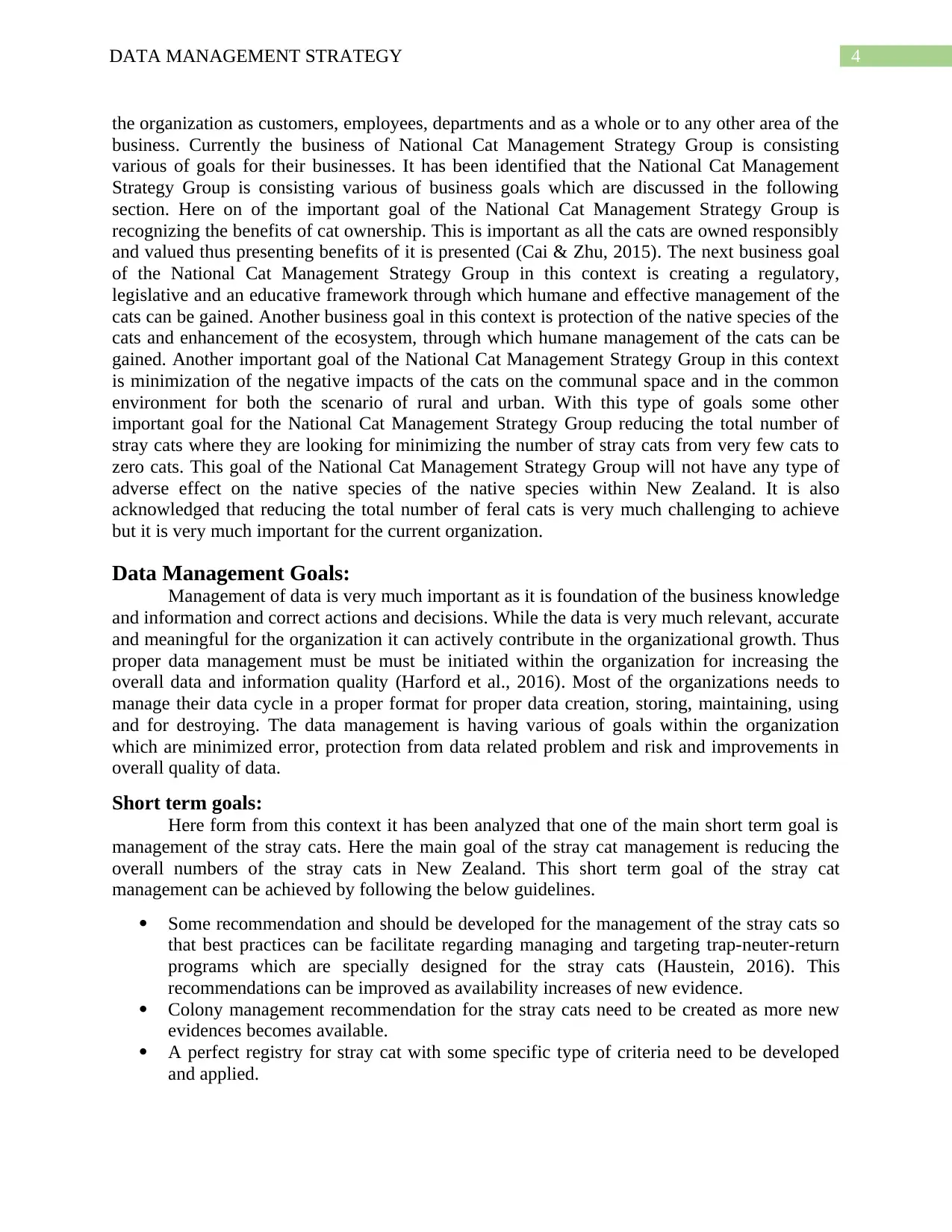
4DATA MANAGEMENT STRATEGY
the organization as customers, employees, departments and as a whole or to any other area of the
business. Currently the business of National Cat Management Strategy Group is consisting
various of goals for their businesses. It has been identified that the National Cat Management
Strategy Group is consisting various of business goals which are discussed in the following
section. Here on of the important goal of the National Cat Management Strategy Group is
recognizing the benefits of cat ownership. This is important as all the cats are owned responsibly
and valued thus presenting benefits of it is presented (Cai & Zhu, 2015). The next business goal
of the National Cat Management Strategy Group in this context is creating a regulatory,
legislative and an educative framework through which humane and effective management of the
cats can be gained. Another business goal in this context is protection of the native species of the
cats and enhancement of the ecosystem, through which humane management of the cats can be
gained. Another important goal of the National Cat Management Strategy Group in this context
is minimization of the negative impacts of the cats on the communal space and in the common
environment for both the scenario of rural and urban. With this type of goals some other
important goal for the National Cat Management Strategy Group reducing the total number of
stray cats where they are looking for minimizing the number of stray cats from very few cats to
zero cats. This goal of the National Cat Management Strategy Group will not have any type of
adverse effect on the native species of the native species within New Zealand. It is also
acknowledged that reducing the total number of feral cats is very much challenging to achieve
but it is very much important for the current organization.
Data Management Goals:
Management of data is very much important as it is foundation of the business knowledge
and information and correct actions and decisions. While the data is very much relevant, accurate
and meaningful for the organization it can actively contribute in the organizational growth. Thus
proper data management must be must be initiated within the organization for increasing the
overall data and information quality (Harford et al., 2016). Most of the organizations needs to
manage their data cycle in a proper format for proper data creation, storing, maintaining, using
and for destroying. The data management is having various of goals within the organization
which are minimized error, protection from data related problem and risk and improvements in
overall quality of data.
Short term goals:
Here form from this context it has been analyzed that one of the main short term goal is
management of the stray cats. Here the main goal of the stray cat management is reducing the
overall numbers of the stray cats in New Zealand. This short term goal of the stray cat
management can be achieved by following the below guidelines.
Some recommendation and should be developed for the management of the stray cats so
that best practices can be facilitate regarding managing and targeting trap-neuter-return
programs which are specially designed for the stray cats (Haustein, 2016). This
recommendations can be improved as availability increases of new evidence.
Colony management recommendation for the stray cats need to be created as more new
evidences becomes available.
A perfect registry for stray cat with some specific type of criteria need to be developed
and applied.
the organization as customers, employees, departments and as a whole or to any other area of the
business. Currently the business of National Cat Management Strategy Group is consisting
various of goals for their businesses. It has been identified that the National Cat Management
Strategy Group is consisting various of business goals which are discussed in the following
section. Here on of the important goal of the National Cat Management Strategy Group is
recognizing the benefits of cat ownership. This is important as all the cats are owned responsibly
and valued thus presenting benefits of it is presented (Cai & Zhu, 2015). The next business goal
of the National Cat Management Strategy Group in this context is creating a regulatory,
legislative and an educative framework through which humane and effective management of the
cats can be gained. Another business goal in this context is protection of the native species of the
cats and enhancement of the ecosystem, through which humane management of the cats can be
gained. Another important goal of the National Cat Management Strategy Group in this context
is minimization of the negative impacts of the cats on the communal space and in the common
environment for both the scenario of rural and urban. With this type of goals some other
important goal for the National Cat Management Strategy Group reducing the total number of
stray cats where they are looking for minimizing the number of stray cats from very few cats to
zero cats. This goal of the National Cat Management Strategy Group will not have any type of
adverse effect on the native species of the native species within New Zealand. It is also
acknowledged that reducing the total number of feral cats is very much challenging to achieve
but it is very much important for the current organization.
Data Management Goals:
Management of data is very much important as it is foundation of the business knowledge
and information and correct actions and decisions. While the data is very much relevant, accurate
and meaningful for the organization it can actively contribute in the organizational growth. Thus
proper data management must be must be initiated within the organization for increasing the
overall data and information quality (Harford et al., 2016). Most of the organizations needs to
manage their data cycle in a proper format for proper data creation, storing, maintaining, using
and for destroying. The data management is having various of goals within the organization
which are minimized error, protection from data related problem and risk and improvements in
overall quality of data.
Short term goals:
Here form from this context it has been analyzed that one of the main short term goal is
management of the stray cats. Here the main goal of the stray cat management is reducing the
overall numbers of the stray cats in New Zealand. This short term goal of the stray cat
management can be achieved by following the below guidelines.
Some recommendation and should be developed for the management of the stray cats so
that best practices can be facilitate regarding managing and targeting trap-neuter-return
programs which are specially designed for the stray cats (Haustein, 2016). This
recommendations can be improved as availability increases of new evidence.
Colony management recommendation for the stray cats need to be created as more new
evidences becomes available.
A perfect registry for stray cat with some specific type of criteria need to be developed
and applied.
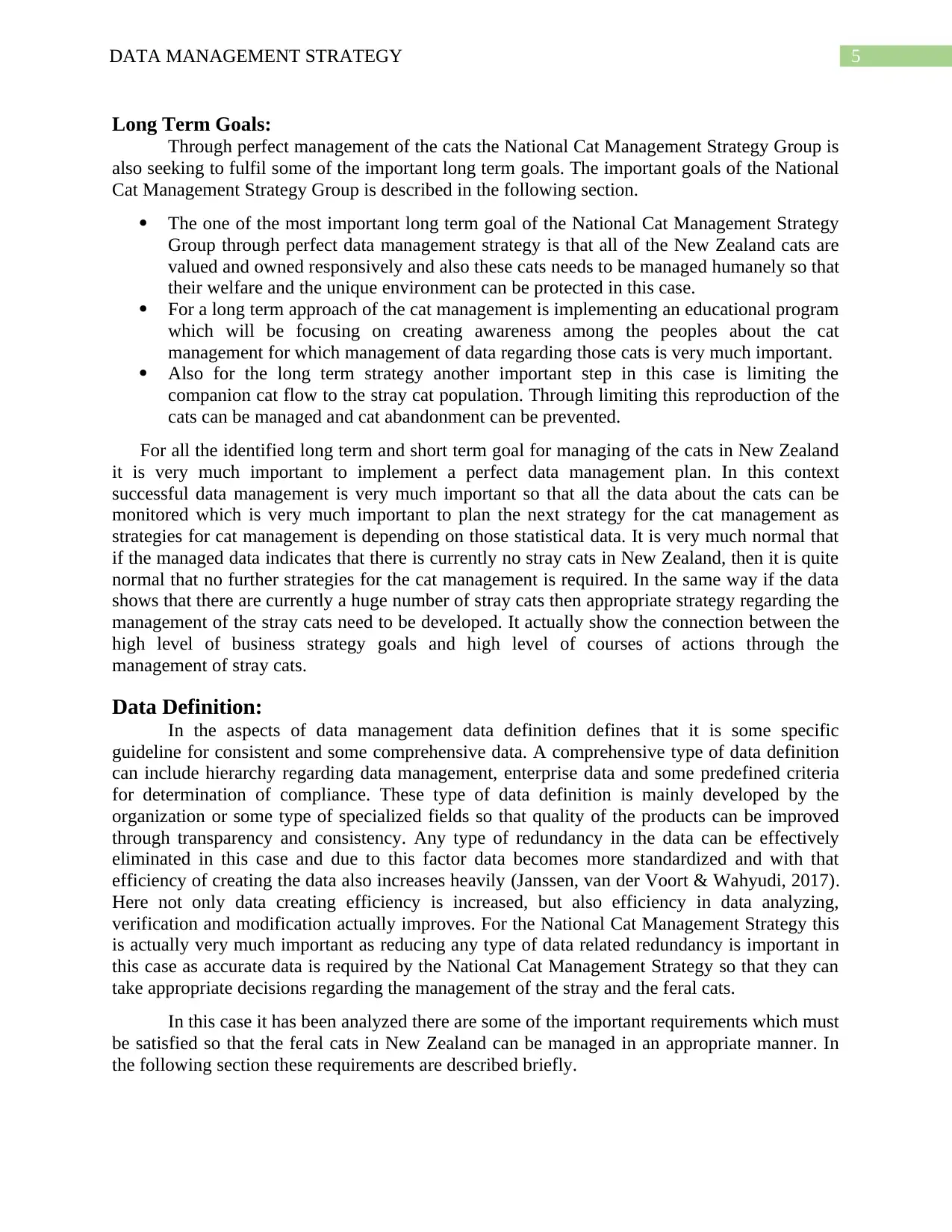
5DATA MANAGEMENT STRATEGY
Long Term Goals:
Through perfect management of the cats the National Cat Management Strategy Group is
also seeking to fulfil some of the important long term goals. The important goals of the National
Cat Management Strategy Group is described in the following section.
The one of the most important long term goal of the National Cat Management Strategy
Group through perfect data management strategy is that all of the New Zealand cats are
valued and owned responsively and also these cats needs to be managed humanely so that
their welfare and the unique environment can be protected in this case.
For a long term approach of the cat management is implementing an educational program
which will be focusing on creating awareness among the peoples about the cat
management for which management of data regarding those cats is very much important.
Also for the long term strategy another important step in this case is limiting the
companion cat flow to the stray cat population. Through limiting this reproduction of the
cats can be managed and cat abandonment can be prevented.
For all the identified long term and short term goal for managing of the cats in New Zealand
it is very much important to implement a perfect data management plan. In this context
successful data management is very much important so that all the data about the cats can be
monitored which is very much important to plan the next strategy for the cat management as
strategies for cat management is depending on those statistical data. It is very much normal that
if the managed data indicates that there is currently no stray cats in New Zealand, then it is quite
normal that no further strategies for the cat management is required. In the same way if the data
shows that there are currently a huge number of stray cats then appropriate strategy regarding the
management of the stray cats need to be developed. It actually show the connection between the
high level of business strategy goals and high level of courses of actions through the
management of stray cats.
Data Definition:
In the aspects of data management data definition defines that it is some specific
guideline for consistent and some comprehensive data. A comprehensive type of data definition
can include hierarchy regarding data management, enterprise data and some predefined criteria
for determination of compliance. These type of data definition is mainly developed by the
organization or some type of specialized fields so that quality of the products can be improved
through transparency and consistency. Any type of redundancy in the data can be effectively
eliminated in this case and due to this factor data becomes more standardized and with that
efficiency of creating the data also increases heavily (Janssen, van der Voort & Wahyudi, 2017).
Here not only data creating efficiency is increased, but also efficiency in data analyzing,
verification and modification actually improves. For the National Cat Management Strategy this
is actually very much important as reducing any type of data related redundancy is important in
this case as accurate data is required by the National Cat Management Strategy so that they can
take appropriate decisions regarding the management of the stray and the feral cats.
In this case it has been analyzed there are some of the important requirements which must
be satisfied so that the feral cats in New Zealand can be managed in an appropriate manner. In
the following section these requirements are described briefly.
Long Term Goals:
Through perfect management of the cats the National Cat Management Strategy Group is
also seeking to fulfil some of the important long term goals. The important goals of the National
Cat Management Strategy Group is described in the following section.
The one of the most important long term goal of the National Cat Management Strategy
Group through perfect data management strategy is that all of the New Zealand cats are
valued and owned responsively and also these cats needs to be managed humanely so that
their welfare and the unique environment can be protected in this case.
For a long term approach of the cat management is implementing an educational program
which will be focusing on creating awareness among the peoples about the cat
management for which management of data regarding those cats is very much important.
Also for the long term strategy another important step in this case is limiting the
companion cat flow to the stray cat population. Through limiting this reproduction of the
cats can be managed and cat abandonment can be prevented.
For all the identified long term and short term goal for managing of the cats in New Zealand
it is very much important to implement a perfect data management plan. In this context
successful data management is very much important so that all the data about the cats can be
monitored which is very much important to plan the next strategy for the cat management as
strategies for cat management is depending on those statistical data. It is very much normal that
if the managed data indicates that there is currently no stray cats in New Zealand, then it is quite
normal that no further strategies for the cat management is required. In the same way if the data
shows that there are currently a huge number of stray cats then appropriate strategy regarding the
management of the stray cats need to be developed. It actually show the connection between the
high level of business strategy goals and high level of courses of actions through the
management of stray cats.
Data Definition:
In the aspects of data management data definition defines that it is some specific
guideline for consistent and some comprehensive data. A comprehensive type of data definition
can include hierarchy regarding data management, enterprise data and some predefined criteria
for determination of compliance. These type of data definition is mainly developed by the
organization or some type of specialized fields so that quality of the products can be improved
through transparency and consistency. Any type of redundancy in the data can be effectively
eliminated in this case and due to this factor data becomes more standardized and with that
efficiency of creating the data also increases heavily (Janssen, van der Voort & Wahyudi, 2017).
Here not only data creating efficiency is increased, but also efficiency in data analyzing,
verification and modification actually improves. For the National Cat Management Strategy this
is actually very much important as reducing any type of data related redundancy is important in
this case as accurate data is required by the National Cat Management Strategy so that they can
take appropriate decisions regarding the management of the stray and the feral cats.
In this case it has been analyzed there are some of the important requirements which must
be satisfied so that the feral cats in New Zealand can be managed in an appropriate manner. In
the following section these requirements are described briefly.

6DATA MANAGEMENT STRATEGY
Controlling overall number of feral cats is one of the most important requirement in this
case. Here for controlling the total number of feral cats the National Cat Management
Strategy is aiming to reduce the total number of feral to zero. Thus in this case it has been
assessed that poisoning is one of the very effective way for controlling the overall
number of feral cats.
Another way of managing the feral cats for the National Cat Management Strategy Group
is catching the feral cats of New Zealand. It has been assessed that one of the most
efficient way for catching the feral cats is trapping them. Here some sort of device can be
used to catch the feral cats. But in this case the traps need to be functional in such a way
that the cats remain alive after being trapped.
Direct kill is another way to manage the overall number of feral cats in New Zealand. In
such type of cases where poisoning and trapping the feral cats is not possible, direct kill
of the feral cats is very much effective. In such of the scenario for direct kill of the feral
cats shooting can be used where a person need to locate and shoot the feral cats. Actually,
this technique of managing the feral cats is ineffective as locating and shooting the feral
cats is very much difficult and for that opportunistic situations are required. As the
shooting of the feral cats is very much hard in this case this technique is generally used as
a supplementary technique to trapping and poisoning the feral cats.
With the management of the feral cats it is also very much important to manage the domestic
cats of the peoples of New Zealand. Currently there is no specific type of strategy for the
management of local cats. Still it is very much significant to build a proper strategy for
management of the stray cats which includes stray cats and the companion cats. The main
requirement for managing the stray cats are described in the following section.
Here the quantity of stray cats can be managed by minimizing the overall amount of stray
cats. One of the main way of removing the stray cats is adoption. The adoption programs
can be initiated in this case so that the cats can be removed from the stray population. The
cats will find their permanent house and due to this factor the number of unclaimed cats
will be reduced in New Zealand. Thus the adoption program is one of the most important
requirement for effective management of the cats in New Zealand.
After the adoption program also there can be some problem regarding the cats as it is
very much natural that the all the cats will not be adopted in this program. Thus some
alternative ways need to be developed in this case. It has been assessed that cat
sanctuaries development is on the most important requirement in this case. By the
development of the stray cats long term homes can be created for the cats within a
confined area. This cat sanctuaries can provide high quality life to the stray cats. Due to
this reason for managing the stray cats development of the stray cats is one of the most
important requirement. One of the major drawback in this case is that building this type
of sanctuaries is very much expensive to build.
Like the feral cats, stray cats can also be caught by using a trapping mechanism. By
trapping those cats, the cats can be taken into the mainstream of the human life and by
this overall number of stray cats can be reduced in this case. Thus for the effective
management of the cats implementation of the trapping machines is very much important
in this case.
Desexing is another option in this case for management of the cats in New Zealand.
Desexing can be done of the stray cats for so that further population of the stray cats can
Controlling overall number of feral cats is one of the most important requirement in this
case. Here for controlling the total number of feral cats the National Cat Management
Strategy is aiming to reduce the total number of feral to zero. Thus in this case it has been
assessed that poisoning is one of the very effective way for controlling the overall
number of feral cats.
Another way of managing the feral cats for the National Cat Management Strategy Group
is catching the feral cats of New Zealand. It has been assessed that one of the most
efficient way for catching the feral cats is trapping them. Here some sort of device can be
used to catch the feral cats. But in this case the traps need to be functional in such a way
that the cats remain alive after being trapped.
Direct kill is another way to manage the overall number of feral cats in New Zealand. In
such type of cases where poisoning and trapping the feral cats is not possible, direct kill
of the feral cats is very much effective. In such of the scenario for direct kill of the feral
cats shooting can be used where a person need to locate and shoot the feral cats. Actually,
this technique of managing the feral cats is ineffective as locating and shooting the feral
cats is very much difficult and for that opportunistic situations are required. As the
shooting of the feral cats is very much hard in this case this technique is generally used as
a supplementary technique to trapping and poisoning the feral cats.
With the management of the feral cats it is also very much important to manage the domestic
cats of the peoples of New Zealand. Currently there is no specific type of strategy for the
management of local cats. Still it is very much significant to build a proper strategy for
management of the stray cats which includes stray cats and the companion cats. The main
requirement for managing the stray cats are described in the following section.
Here the quantity of stray cats can be managed by minimizing the overall amount of stray
cats. One of the main way of removing the stray cats is adoption. The adoption programs
can be initiated in this case so that the cats can be removed from the stray population. The
cats will find their permanent house and due to this factor the number of unclaimed cats
will be reduced in New Zealand. Thus the adoption program is one of the most important
requirement for effective management of the cats in New Zealand.
After the adoption program also there can be some problem regarding the cats as it is
very much natural that the all the cats will not be adopted in this program. Thus some
alternative ways need to be developed in this case. It has been assessed that cat
sanctuaries development is on the most important requirement in this case. By the
development of the stray cats long term homes can be created for the cats within a
confined area. This cat sanctuaries can provide high quality life to the stray cats. Due to
this reason for managing the stray cats development of the stray cats is one of the most
important requirement. One of the major drawback in this case is that building this type
of sanctuaries is very much expensive to build.
Like the feral cats, stray cats can also be caught by using a trapping mechanism. By
trapping those cats, the cats can be taken into the mainstream of the human life and by
this overall number of stray cats can be reduced in this case. Thus for the effective
management of the cats implementation of the trapping machines is very much important
in this case.
Desexing is another option in this case for management of the cats in New Zealand.
Desexing can be done of the stray cats for so that further population of the stray cats can
Secure Best Marks with AI Grader
Need help grading? Try our AI Grader for instant feedback on your assignments.
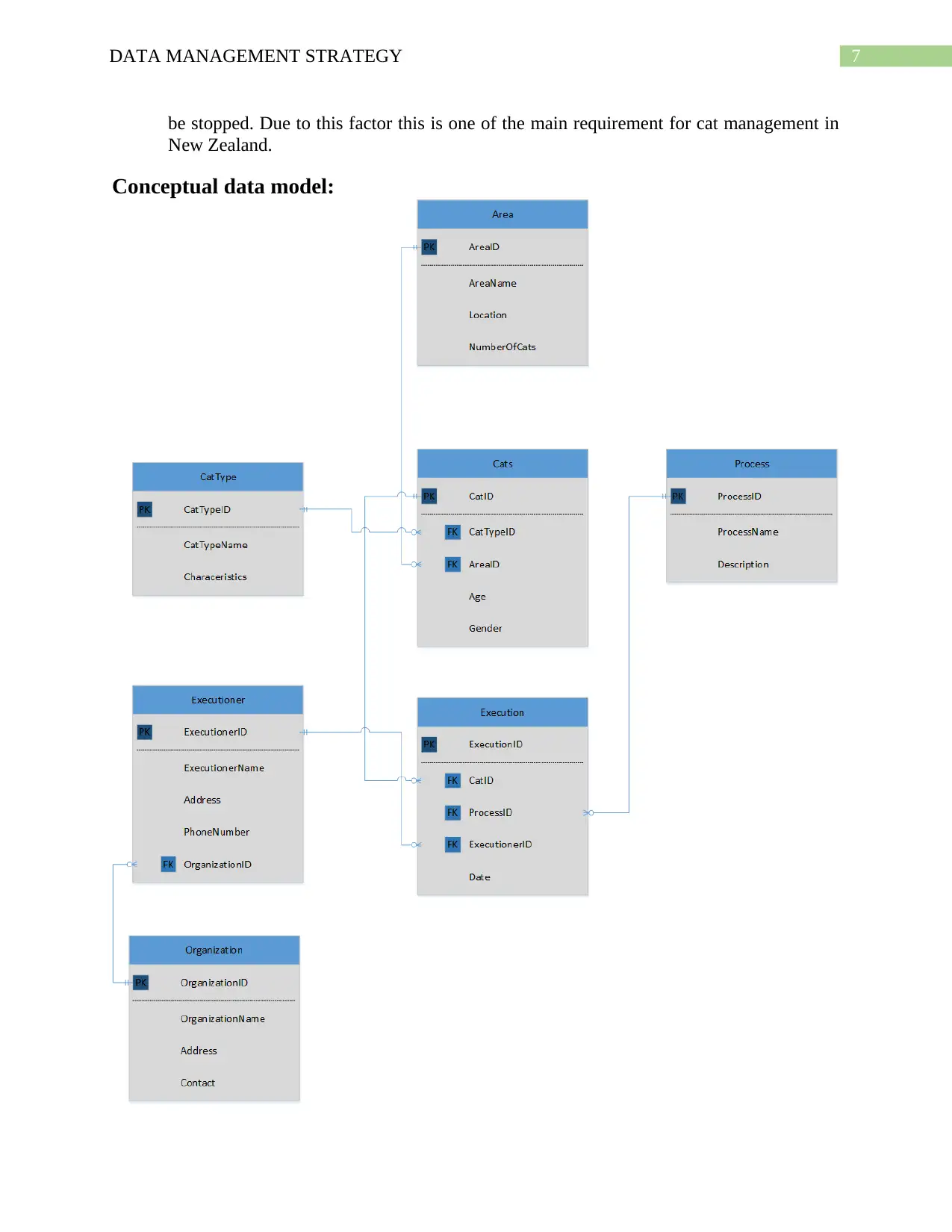
7DATA MANAGEMENT STRATEGY
be stopped. Due to this factor this is one of the main requirement for cat management in
New Zealand.
Conceptual data model:
be stopped. Due to this factor this is one of the main requirement for cat management in
New Zealand.
Conceptual data model:
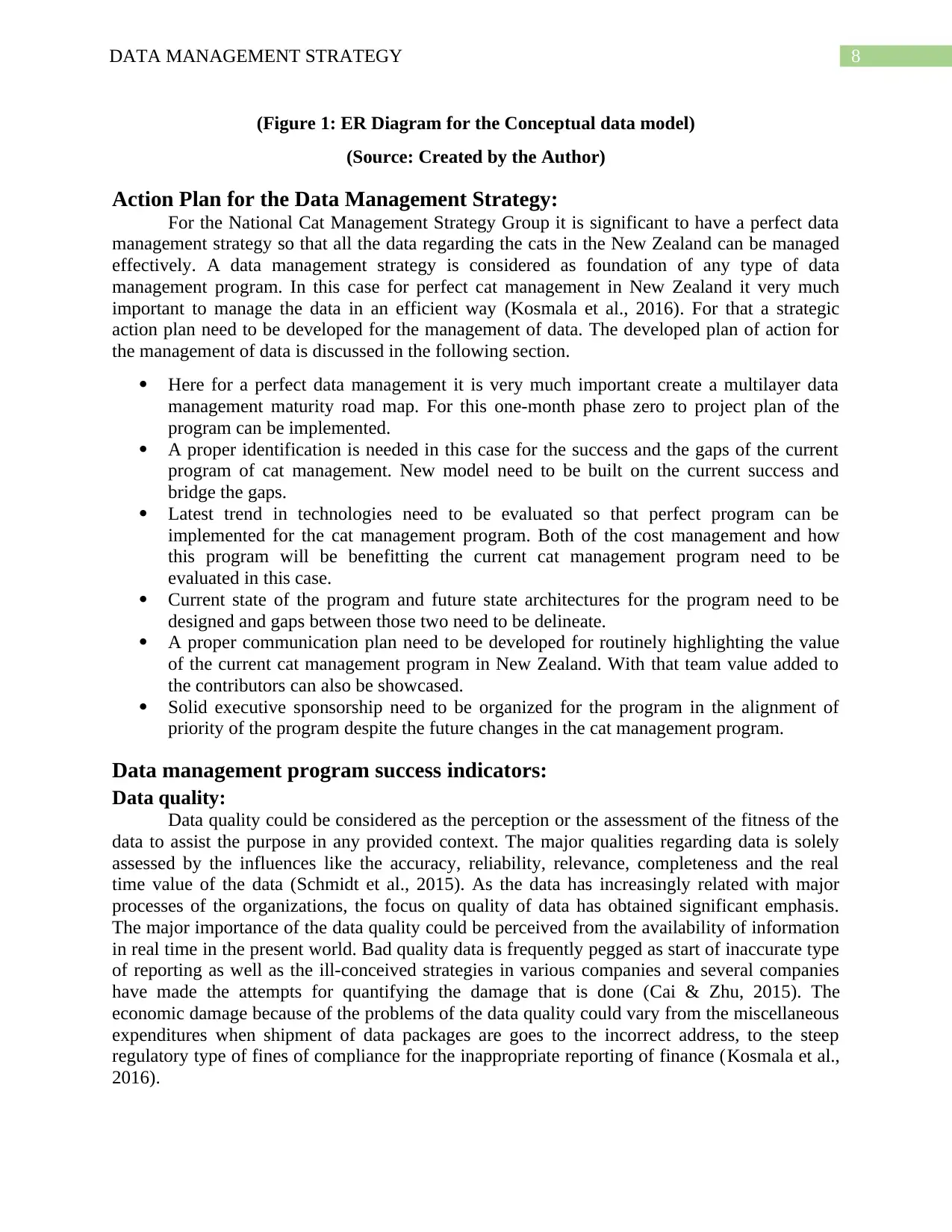
8DATA MANAGEMENT STRATEGY
(Figure 1: ER Diagram for the Conceptual data model)
(Source: Created by the Author)
Action Plan for the Data Management Strategy:
For the National Cat Management Strategy Group it is significant to have a perfect data
management strategy so that all the data regarding the cats in the New Zealand can be managed
effectively. A data management strategy is considered as foundation of any type of data
management program. In this case for perfect cat management in New Zealand it very much
important to manage the data in an efficient way (Kosmala et al., 2016). For that a strategic
action plan need to be developed for the management of data. The developed plan of action for
the management of data is discussed in the following section.
Here for a perfect data management it is very much important create a multilayer data
management maturity road map. For this one-month phase zero to project plan of the
program can be implemented.
A proper identification is needed in this case for the success and the gaps of the current
program of cat management. New model need to be built on the current success and
bridge the gaps.
Latest trend in technologies need to be evaluated so that perfect program can be
implemented for the cat management program. Both of the cost management and how
this program will be benefitting the current cat management program need to be
evaluated in this case.
Current state of the program and future state architectures for the program need to be
designed and gaps between those two need to be delineate.
A proper communication plan need to be developed for routinely highlighting the value
of the current cat management program in New Zealand. With that team value added to
the contributors can also be showcased.
Solid executive sponsorship need to be organized for the program in the alignment of
priority of the program despite the future changes in the cat management program.
Data management program success indicators:
Data quality:
Data quality could be considered as the perception or the assessment of the fitness of the
data to assist the purpose in any provided context. The major qualities regarding data is solely
assessed by the influences like the accuracy, reliability, relevance, completeness and the real
time value of the data (Schmidt et al., 2015). As the data has increasingly related with major
processes of the organizations, the focus on quality of data has obtained significant emphasis.
The major importance of the data quality could be perceived from the availability of information
in real time in the present world. Bad quality data is frequently pegged as start of inaccurate type
of reporting as well as the ill-conceived strategies in various companies and several companies
have made the attempts for quantifying the damage that is done (Cai & Zhu, 2015). The
economic damage because of the problems of the data quality could vary from the miscellaneous
expenditures when shipment of data packages are goes to the incorrect address, to the steep
regulatory type of fines of compliance for the inappropriate reporting of finance (Kosmala et al.,
2016).
(Figure 1: ER Diagram for the Conceptual data model)
(Source: Created by the Author)
Action Plan for the Data Management Strategy:
For the National Cat Management Strategy Group it is significant to have a perfect data
management strategy so that all the data regarding the cats in the New Zealand can be managed
effectively. A data management strategy is considered as foundation of any type of data
management program. In this case for perfect cat management in New Zealand it very much
important to manage the data in an efficient way (Kosmala et al., 2016). For that a strategic
action plan need to be developed for the management of data. The developed plan of action for
the management of data is discussed in the following section.
Here for a perfect data management it is very much important create a multilayer data
management maturity road map. For this one-month phase zero to project plan of the
program can be implemented.
A proper identification is needed in this case for the success and the gaps of the current
program of cat management. New model need to be built on the current success and
bridge the gaps.
Latest trend in technologies need to be evaluated so that perfect program can be
implemented for the cat management program. Both of the cost management and how
this program will be benefitting the current cat management program need to be
evaluated in this case.
Current state of the program and future state architectures for the program need to be
designed and gaps between those two need to be delineate.
A proper communication plan need to be developed for routinely highlighting the value
of the current cat management program in New Zealand. With that team value added to
the contributors can also be showcased.
Solid executive sponsorship need to be organized for the program in the alignment of
priority of the program despite the future changes in the cat management program.
Data management program success indicators:
Data quality:
Data quality could be considered as the perception or the assessment of the fitness of the
data to assist the purpose in any provided context. The major qualities regarding data is solely
assessed by the influences like the accuracy, reliability, relevance, completeness and the real
time value of the data (Schmidt et al., 2015). As the data has increasingly related with major
processes of the organizations, the focus on quality of data has obtained significant emphasis.
The major importance of the data quality could be perceived from the availability of information
in real time in the present world. Bad quality data is frequently pegged as start of inaccurate type
of reporting as well as the ill-conceived strategies in various companies and several companies
have made the attempts for quantifying the damage that is done (Cai & Zhu, 2015). The
economic damage because of the problems of the data quality could vary from the miscellaneous
expenditures when shipment of data packages are goes to the incorrect address, to the steep
regulatory type of fines of compliance for the inappropriate reporting of finance (Kosmala et al.,
2016).
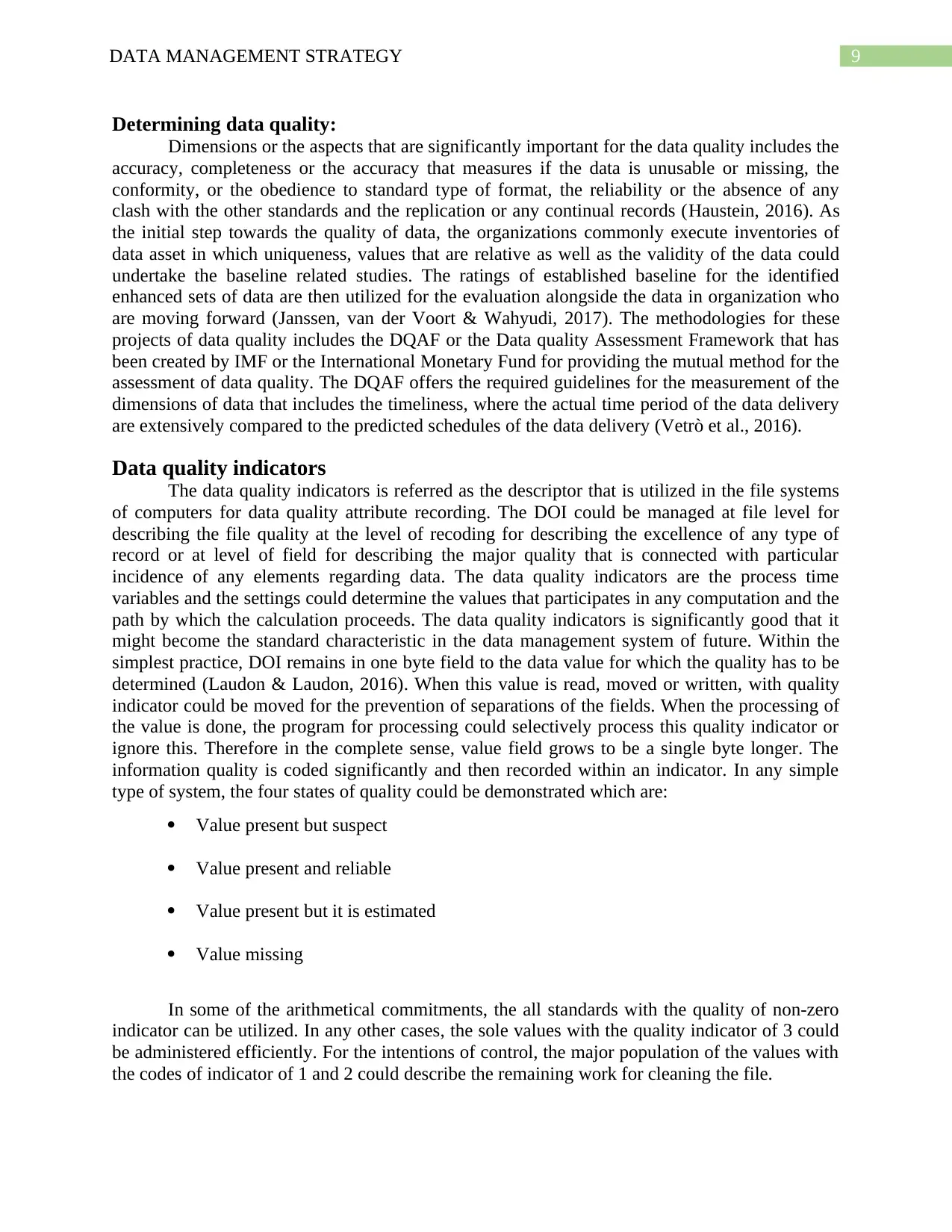
9DATA MANAGEMENT STRATEGY
Determining data quality:
Dimensions or the aspects that are significantly important for the data quality includes the
accuracy, completeness or the accuracy that measures if the data is unusable or missing, the
conformity, or the obedience to standard type of format, the reliability or the absence of any
clash with the other standards and the replication or any continual records (Haustein, 2016). As
the initial step towards the quality of data, the organizations commonly execute inventories of
data asset in which uniqueness, values that are relative as well as the validity of the data could
undertake the baseline related studies. The ratings of established baseline for the identified
enhanced sets of data are then utilized for the evaluation alongside the data in organization who
are moving forward (Janssen, van der Voort & Wahyudi, 2017). The methodologies for these
projects of data quality includes the DQAF or the Data quality Assessment Framework that has
been created by IMF or the International Monetary Fund for providing the mutual method for the
assessment of data quality. The DQAF offers the required guidelines for the measurement of the
dimensions of data that includes the timeliness, where the actual time period of the data delivery
are extensively compared to the predicted schedules of the data delivery (Vetrò et al., 2016).
Data quality indicators
The data quality indicators is referred as the descriptor that is utilized in the file systems
of computers for data quality attribute recording. The DOI could be managed at file level for
describing the file quality at the level of recoding for describing the excellence of any type of
record or at level of field for describing the major quality that is connected with particular
incidence of any elements regarding data. The data quality indicators are the process time
variables and the settings could determine the values that participates in any computation and the
path by which the calculation proceeds. The data quality indicators is significantly good that it
might become the standard characteristic in the data management system of future. Within the
simplest practice, DOI remains in one byte field to the data value for which the quality has to be
determined (Laudon & Laudon, 2016). When this value is read, moved or written, with quality
indicator could be moved for the prevention of separations of the fields. When the processing of
the value is done, the program for processing could selectively process this quality indicator or
ignore this. Therefore in the complete sense, value field grows to be a single byte longer. The
information quality is coded significantly and then recorded within an indicator. In any simple
type of system, the four states of quality could be demonstrated which are:
Value present but suspect
Value present and reliable
Value present but it is estimated
Value missing
In some of the arithmetical commitments, the all standards with the quality of non-zero
indicator can be utilized. In any other cases, the sole values with the quality indicator of 3 could
be administered efficiently. For the intentions of control, the major population of the values with
the codes of indicator of 1 and 2 could describe the remaining work for cleaning the file.
Determining data quality:
Dimensions or the aspects that are significantly important for the data quality includes the
accuracy, completeness or the accuracy that measures if the data is unusable or missing, the
conformity, or the obedience to standard type of format, the reliability or the absence of any
clash with the other standards and the replication or any continual records (Haustein, 2016). As
the initial step towards the quality of data, the organizations commonly execute inventories of
data asset in which uniqueness, values that are relative as well as the validity of the data could
undertake the baseline related studies. The ratings of established baseline for the identified
enhanced sets of data are then utilized for the evaluation alongside the data in organization who
are moving forward (Janssen, van der Voort & Wahyudi, 2017). The methodologies for these
projects of data quality includes the DQAF or the Data quality Assessment Framework that has
been created by IMF or the International Monetary Fund for providing the mutual method for the
assessment of data quality. The DQAF offers the required guidelines for the measurement of the
dimensions of data that includes the timeliness, where the actual time period of the data delivery
are extensively compared to the predicted schedules of the data delivery (Vetrò et al., 2016).
Data quality indicators
The data quality indicators is referred as the descriptor that is utilized in the file systems
of computers for data quality attribute recording. The DOI could be managed at file level for
describing the file quality at the level of recoding for describing the excellence of any type of
record or at level of field for describing the major quality that is connected with particular
incidence of any elements regarding data. The data quality indicators are the process time
variables and the settings could determine the values that participates in any computation and the
path by which the calculation proceeds. The data quality indicators is significantly good that it
might become the standard characteristic in the data management system of future. Within the
simplest practice, DOI remains in one byte field to the data value for which the quality has to be
determined (Laudon & Laudon, 2016). When this value is read, moved or written, with quality
indicator could be moved for the prevention of separations of the fields. When the processing of
the value is done, the program for processing could selectively process this quality indicator or
ignore this. Therefore in the complete sense, value field grows to be a single byte longer. The
information quality is coded significantly and then recorded within an indicator. In any simple
type of system, the four states of quality could be demonstrated which are:
Value present but suspect
Value present and reliable
Value present but it is estimated
Value missing
In some of the arithmetical commitments, the all standards with the quality of non-zero
indicator can be utilized. In any other cases, the sole values with the quality indicator of 3 could
be administered efficiently. For the intentions of control, the major population of the values with
the codes of indicator of 1 and 2 could describe the remaining work for cleaning the file.
Paraphrase This Document
Need a fresh take? Get an instant paraphrase of this document with our AI Paraphraser
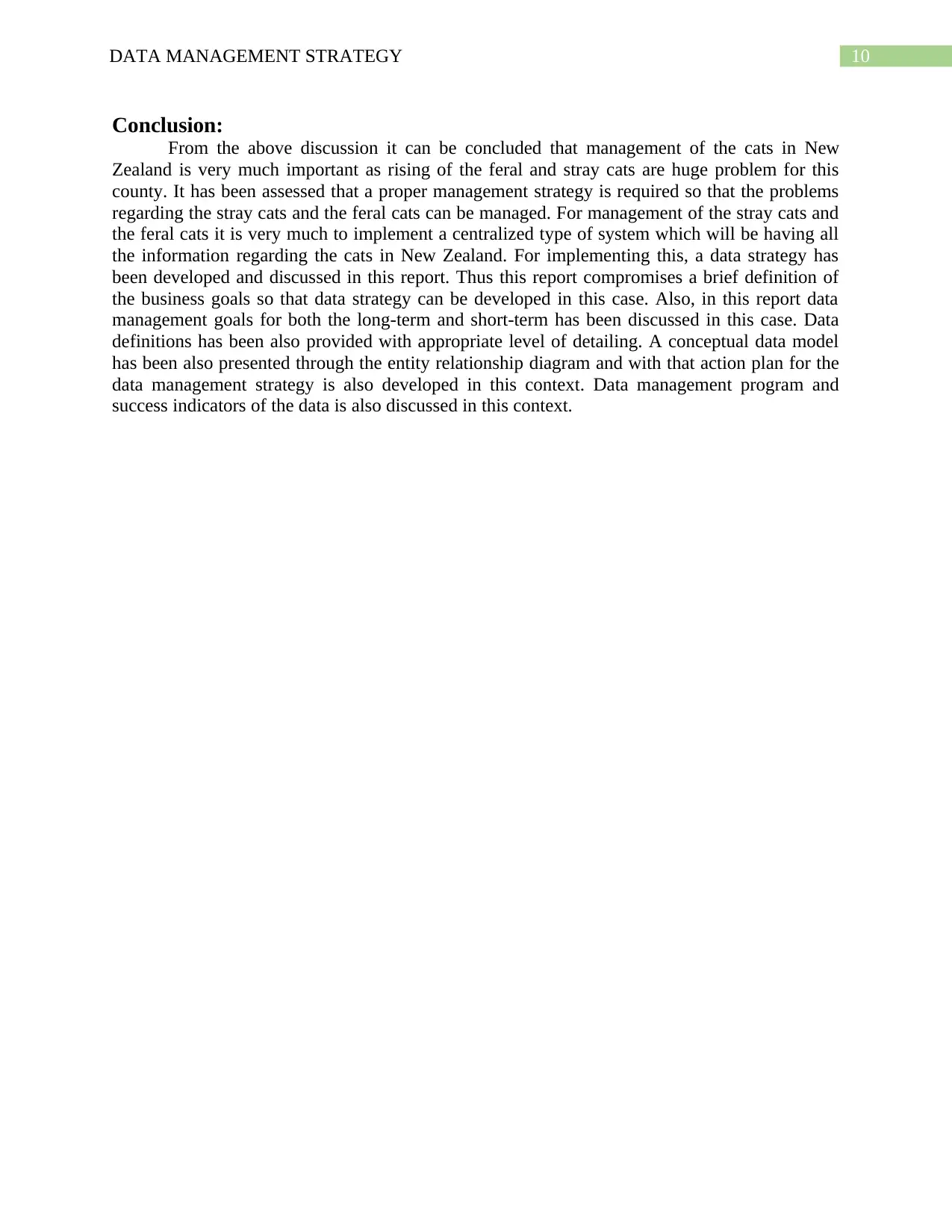
10DATA MANAGEMENT STRATEGY
Conclusion:
From the above discussion it can be concluded that management of the cats in New
Zealand is very much important as rising of the feral and stray cats are huge problem for this
county. It has been assessed that a proper management strategy is required so that the problems
regarding the stray cats and the feral cats can be managed. For management of the stray cats and
the feral cats it is very much to implement a centralized type of system which will be having all
the information regarding the cats in New Zealand. For implementing this, a data strategy has
been developed and discussed in this report. Thus this report compromises a brief definition of
the business goals so that data strategy can be developed in this case. Also, in this report data
management goals for both the long-term and short-term has been discussed in this case. Data
definitions has been also provided with appropriate level of detailing. A conceptual data model
has been also presented through the entity relationship diagram and with that action plan for the
data management strategy is also developed in this context. Data management program and
success indicators of the data is also discussed in this context.
Conclusion:
From the above discussion it can be concluded that management of the cats in New
Zealand is very much important as rising of the feral and stray cats are huge problem for this
county. It has been assessed that a proper management strategy is required so that the problems
regarding the stray cats and the feral cats can be managed. For management of the stray cats and
the feral cats it is very much to implement a centralized type of system which will be having all
the information regarding the cats in New Zealand. For implementing this, a data strategy has
been developed and discussed in this report. Thus this report compromises a brief definition of
the business goals so that data strategy can be developed in this case. Also, in this report data
management goals for both the long-term and short-term has been discussed in this case. Data
definitions has been also provided with appropriate level of detailing. A conceptual data model
has been also presented through the entity relationship diagram and with that action plan for the
data management strategy is also developed in this context. Data management program and
success indicators of the data is also discussed in this context.
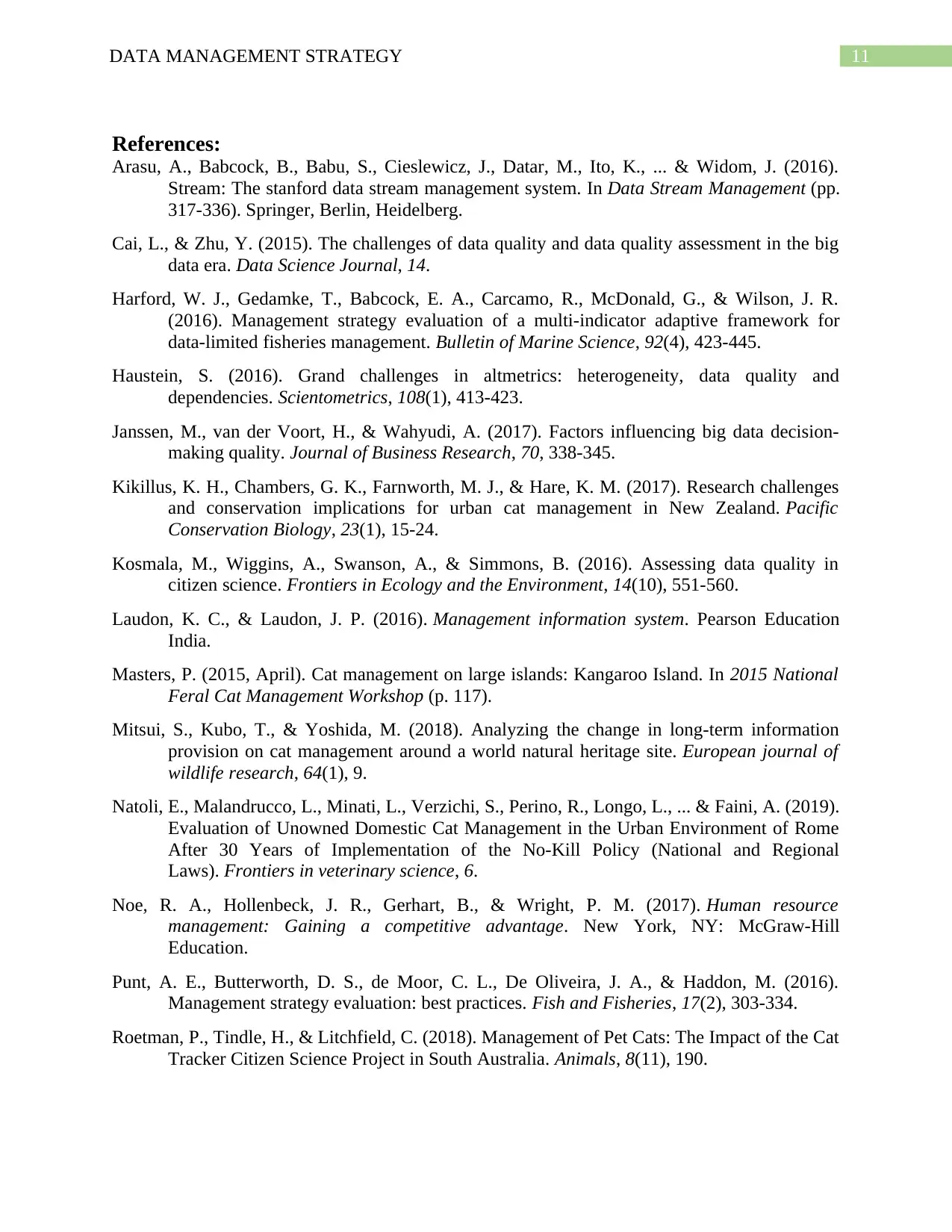
11DATA MANAGEMENT STRATEGY
References:
Arasu, A., Babcock, B., Babu, S., Cieslewicz, J., Datar, M., Ito, K., ... & Widom, J. (2016).
Stream: The stanford data stream management system. In Data Stream Management (pp.
317-336). Springer, Berlin, Heidelberg.
Cai, L., & Zhu, Y. (2015). The challenges of data quality and data quality assessment in the big
data era. Data Science Journal, 14.
Harford, W. J., Gedamke, T., Babcock, E. A., Carcamo, R., McDonald, G., & Wilson, J. R.
(2016). Management strategy evaluation of a multi-indicator adaptive framework for
data-limited fisheries management. Bulletin of Marine Science, 92(4), 423-445.
Haustein, S. (2016). Grand challenges in altmetrics: heterogeneity, data quality and
dependencies. Scientometrics, 108(1), 413-423.
Janssen, M., van der Voort, H., & Wahyudi, A. (2017). Factors influencing big data decision-
making quality. Journal of Business Research, 70, 338-345.
Kikillus, K. H., Chambers, G. K., Farnworth, M. J., & Hare, K. M. (2017). Research challenges
and conservation implications for urban cat management in New Zealand. Pacific
Conservation Biology, 23(1), 15-24.
Kosmala, M., Wiggins, A., Swanson, A., & Simmons, B. (2016). Assessing data quality in
citizen science. Frontiers in Ecology and the Environment, 14(10), 551-560.
Laudon, K. C., & Laudon, J. P. (2016). Management information system. Pearson Education
India.
Masters, P. (2015, April). Cat management on large islands: Kangaroo Island. In 2015 National
Feral Cat Management Workshop (p. 117).
Mitsui, S., Kubo, T., & Yoshida, M. (2018). Analyzing the change in long-term information
provision on cat management around a world natural heritage site. European journal of
wildlife research, 64(1), 9.
Natoli, E., Malandrucco, L., Minati, L., Verzichi, S., Perino, R., Longo, L., ... & Faini, A. (2019).
Evaluation of Unowned Domestic Cat Management in the Urban Environment of Rome
After 30 Years of Implementation of the No-Kill Policy (National and Regional
Laws). Frontiers in veterinary science, 6.
Noe, R. A., Hollenbeck, J. R., Gerhart, B., & Wright, P. M. (2017). Human resource
management: Gaining a competitive advantage. New York, NY: McGraw-Hill
Education.
Punt, A. E., Butterworth, D. S., de Moor, C. L., De Oliveira, J. A., & Haddon, M. (2016).
Management strategy evaluation: best practices. Fish and Fisheries, 17(2), 303-334.
Roetman, P., Tindle, H., & Litchfield, C. (2018). Management of Pet Cats: The Impact of the Cat
Tracker Citizen Science Project in South Australia. Animals, 8(11), 190.
References:
Arasu, A., Babcock, B., Babu, S., Cieslewicz, J., Datar, M., Ito, K., ... & Widom, J. (2016).
Stream: The stanford data stream management system. In Data Stream Management (pp.
317-336). Springer, Berlin, Heidelberg.
Cai, L., & Zhu, Y. (2015). The challenges of data quality and data quality assessment in the big
data era. Data Science Journal, 14.
Harford, W. J., Gedamke, T., Babcock, E. A., Carcamo, R., McDonald, G., & Wilson, J. R.
(2016). Management strategy evaluation of a multi-indicator adaptive framework for
data-limited fisheries management. Bulletin of Marine Science, 92(4), 423-445.
Haustein, S. (2016). Grand challenges in altmetrics: heterogeneity, data quality and
dependencies. Scientometrics, 108(1), 413-423.
Janssen, M., van der Voort, H., & Wahyudi, A. (2017). Factors influencing big data decision-
making quality. Journal of Business Research, 70, 338-345.
Kikillus, K. H., Chambers, G. K., Farnworth, M. J., & Hare, K. M. (2017). Research challenges
and conservation implications for urban cat management in New Zealand. Pacific
Conservation Biology, 23(1), 15-24.
Kosmala, M., Wiggins, A., Swanson, A., & Simmons, B. (2016). Assessing data quality in
citizen science. Frontiers in Ecology and the Environment, 14(10), 551-560.
Laudon, K. C., & Laudon, J. P. (2016). Management information system. Pearson Education
India.
Masters, P. (2015, April). Cat management on large islands: Kangaroo Island. In 2015 National
Feral Cat Management Workshop (p. 117).
Mitsui, S., Kubo, T., & Yoshida, M. (2018). Analyzing the change in long-term information
provision on cat management around a world natural heritage site. European journal of
wildlife research, 64(1), 9.
Natoli, E., Malandrucco, L., Minati, L., Verzichi, S., Perino, R., Longo, L., ... & Faini, A. (2019).
Evaluation of Unowned Domestic Cat Management in the Urban Environment of Rome
After 30 Years of Implementation of the No-Kill Policy (National and Regional
Laws). Frontiers in veterinary science, 6.
Noe, R. A., Hollenbeck, J. R., Gerhart, B., & Wright, P. M. (2017). Human resource
management: Gaining a competitive advantage. New York, NY: McGraw-Hill
Education.
Punt, A. E., Butterworth, D. S., de Moor, C. L., De Oliveira, J. A., & Haddon, M. (2016).
Management strategy evaluation: best practices. Fish and Fisheries, 17(2), 303-334.
Roetman, P., Tindle, H., & Litchfield, C. (2018). Management of Pet Cats: The Impact of the Cat
Tracker Citizen Science Project in South Australia. Animals, 8(11), 190.
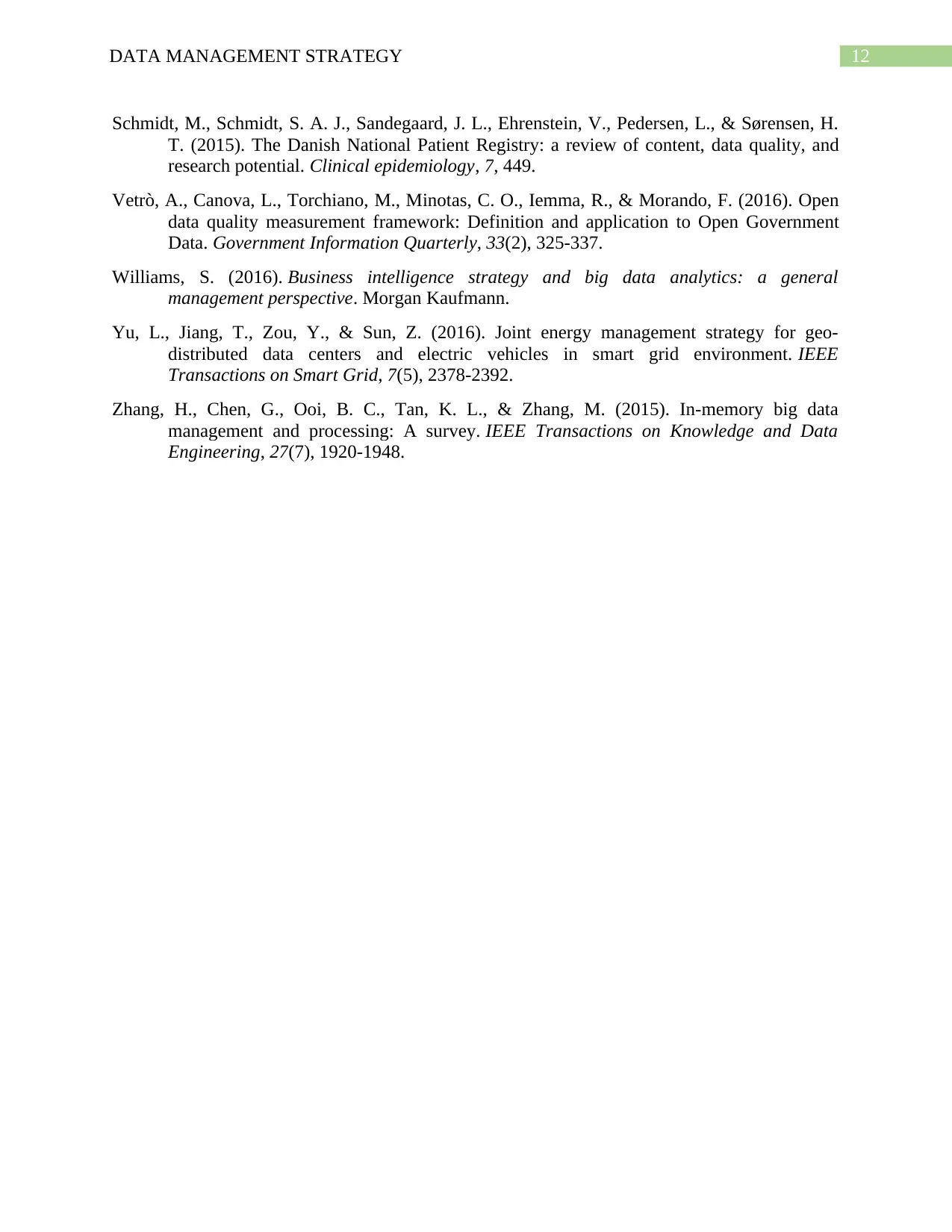
12DATA MANAGEMENT STRATEGY
Schmidt, M., Schmidt, S. A. J., Sandegaard, J. L., Ehrenstein, V., Pedersen, L., & Sørensen, H.
T. (2015). The Danish National Patient Registry: a review of content, data quality, and
research potential. Clinical epidemiology, 7, 449.
Vetrò, A., Canova, L., Torchiano, M., Minotas, C. O., Iemma, R., & Morando, F. (2016). Open
data quality measurement framework: Definition and application to Open Government
Data. Government Information Quarterly, 33(2), 325-337.
Williams, S. (2016). Business intelligence strategy and big data analytics: a general
management perspective. Morgan Kaufmann.
Yu, L., Jiang, T., Zou, Y., & Sun, Z. (2016). Joint energy management strategy for geo-
distributed data centers and electric vehicles in smart grid environment. IEEE
Transactions on Smart Grid, 7(5), 2378-2392.
Zhang, H., Chen, G., Ooi, B. C., Tan, K. L., & Zhang, M. (2015). In-memory big data
management and processing: A survey. IEEE Transactions on Knowledge and Data
Engineering, 27(7), 1920-1948.
Schmidt, M., Schmidt, S. A. J., Sandegaard, J. L., Ehrenstein, V., Pedersen, L., & Sørensen, H.
T. (2015). The Danish National Patient Registry: a review of content, data quality, and
research potential. Clinical epidemiology, 7, 449.
Vetrò, A., Canova, L., Torchiano, M., Minotas, C. O., Iemma, R., & Morando, F. (2016). Open
data quality measurement framework: Definition and application to Open Government
Data. Government Information Quarterly, 33(2), 325-337.
Williams, S. (2016). Business intelligence strategy and big data analytics: a general
management perspective. Morgan Kaufmann.
Yu, L., Jiang, T., Zou, Y., & Sun, Z. (2016). Joint energy management strategy for geo-
distributed data centers and electric vehicles in smart grid environment. IEEE
Transactions on Smart Grid, 7(5), 2378-2392.
Zhang, H., Chen, G., Ooi, B. C., Tan, K. L., & Zhang, M. (2015). In-memory big data
management and processing: A survey. IEEE Transactions on Knowledge and Data
Engineering, 27(7), 1920-1948.
1 out of 13
![[object Object]](/_next/static/media/star-bottom.7253800d.svg)




